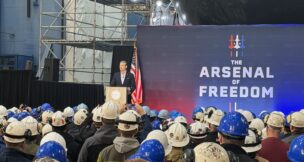Dropping anchor
Port of Virginia remains a draw for industrial real estate

Hampton Roads remains “in a much healthier position than most other industrial [real estate] markets,” says Geoff Poston, senior vice president of Cushman & Wakefield | Thalhimer’s industrial group. Photo by Mark Rhodes

Hampton Roads remains “in a much healthier position than most other industrial [real estate] markets,” says Geoff Poston, senior vice president of Cushman & Wakefield | Thalhimer’s industrial group. Photo by Mark Rhodes
Dropping anchor
Port of Virginia remains a draw for industrial real estate
LS GreenLink USA spent two years on site selection, scouring much of the East Coast for the right location to build a 750,000-square-foot factory to manufacture subsea cables for offshore wind farms.
Then it landed on Chesapeake.
Patrick Shim, LS GreenLink’s managing director, cited several reasons for the company’s decision: access to the Port of Virginia, the approximately 15,000 veterans who enter the civilian workforce each year in the region, and the state, regional and local economic development support for companies like his.
“I’ve never seen anything like it in any other region out there,” Shim says.
In July, LS GreenLink, a U.S. subsidiary of South Korea’s LS Cable & System, announced it would build the United States’ first offshore wind subsea cable factory at the Deep Water Terminal Site in Chesapeake, creating an estimated 381 jobs and investing $681 million.
The port has remained a large attraction for retailers and developers looking to invest in Hampton Roads. Industrial real estate had a 2.3% vacancy rate for the second quarter of 2023, which slipped to 3.6% for the second quarter of 2024, according to Cushman & Wakefield | Thalhimer. But that’s still well below the national rate of 6.6%, according to real estate company JLL.
A national slowdown in imports and rising interest rates are to blame for some of that increase, says Geoff Poston, senior vice president of Cushman & Wakefield | Thalhimer’s industrial group. But it’s not all doom and gloom.
Hampton Roads lagged behind other markets, like Savannah, Georgia, in spec building before the pandemic, but that’s changed in recent years, and more spec buildings are coming online. This contributes to the boost in the region’s vacancy rate, but Poston notes that Hampton Roads remains “in a much healthier position than most other industrial markets.”
That includes Savannah, which posted a 7.9% industrial vacancy rate for the second quarter of 2024.
“We’ve just got through an all-time record historical industrial market, and so this is a little more normal, although the developers, you know, they’d love to have more activity,” Poston says.
The port’s draw
The Port of Virginia’s shipping channel opened to two-way traffic for ultra-large container vessels in March, reducing turnaround time by 15%, according to the port. A central rail expansion that will allow it to handle an extra 455,000 20-foot-equivalent containers (TEUs) a year, bringing the total rail capacity to 1.8 million TEUs annually, was finished in early August.
The port processed 3.5 million TEUs in fiscal 2024, a 2% increase over 2023 and the second best year in its history.
Lang Williams, an executive vice president and principal with Colliers International Virginia and vice president of the Virginia Maritime Association, says trends are reversing, and cargo is beginning to again flow more freely. Coupled with the port’s improvements, he expects the more recent lag in vacancies “will start to go away.”
That could be good news for large projects underway, including more than 3.6 million square feet spread across 11 spec buildings that are either being constructed or anticipated, Colliers reported. That’s on top of four such buildings, totaling more than 1.4 million square feet, completed last year.
Developers Matan and the Rockefeller Group are planning a 5 million-square-foot industrial park on 500 acres in Suffolk, with five spec buildings, two of which are set to be completed by the end of 2025.
“They’re having really good activity for those buildings, and maybe some other activity as well,” Deputy City Manager Kevin Hughes says. Gov. Glenn Youngkin announced in July that the City of Suffolk would receive $30.1 million to widen a 2.3-mile stretch of Route 460 to support the development.
Other high-profile projects are also continuing. Amazon.com is on track to complete a 219,000-square-foot delivery station in Virginia Beach in time for the 2024 holiday season, and a robotics fulfillment center, in an adjacent space, is set to be complete in late 2025, company spokesperson Sam Fisher says.
Also in August, the City of Chesapeake received a $35 million grant from the state’s Virginia Business Ready Sites Program to help extend utility infrastructure to the 1,400-acre Coastal Virginia Commerce Park, according to Steven Wright, the city’s economic development director. The state has looked to the megasite as a possible location for a semiconductor or microchip manufacturer. While Chesapeake is continuing to look for funding for development, Wright says it is close to reaching Tier 4 status.
“Everyone that calls is curious about what is the status of the infrastructure to support the property,” Wright says.
T















